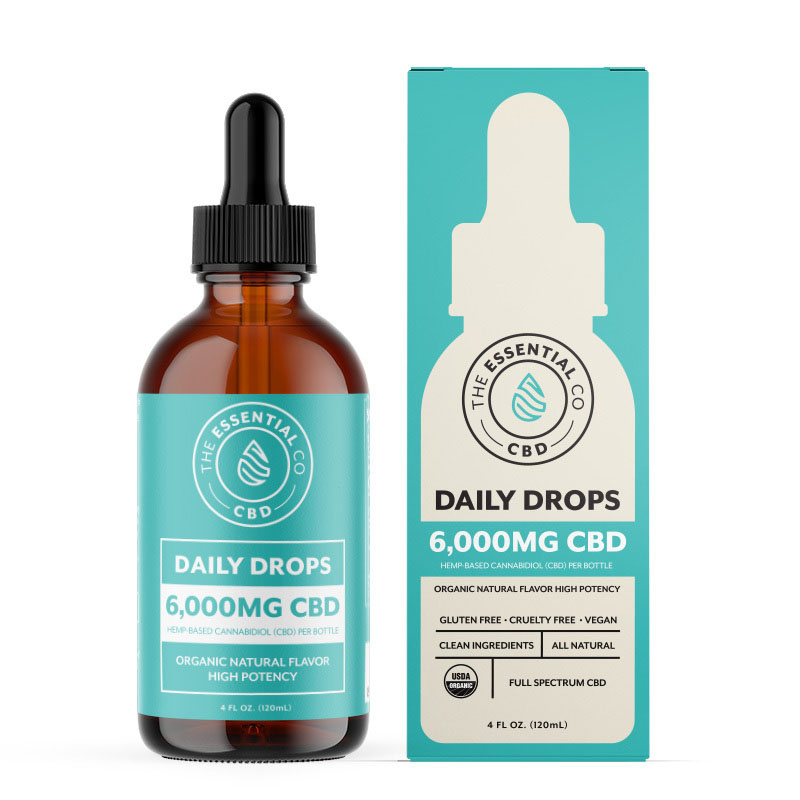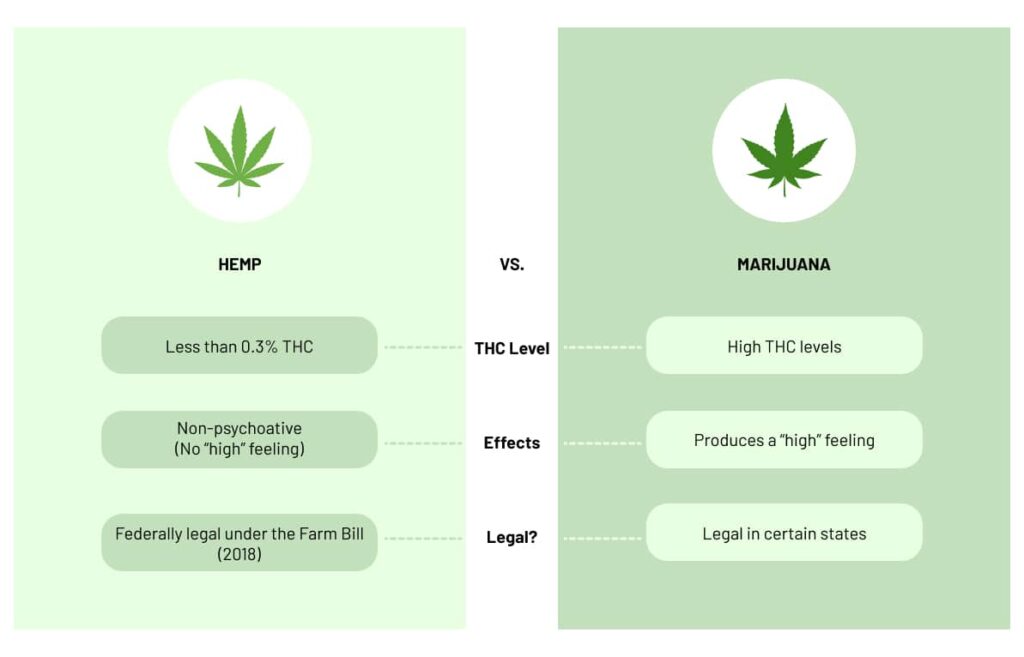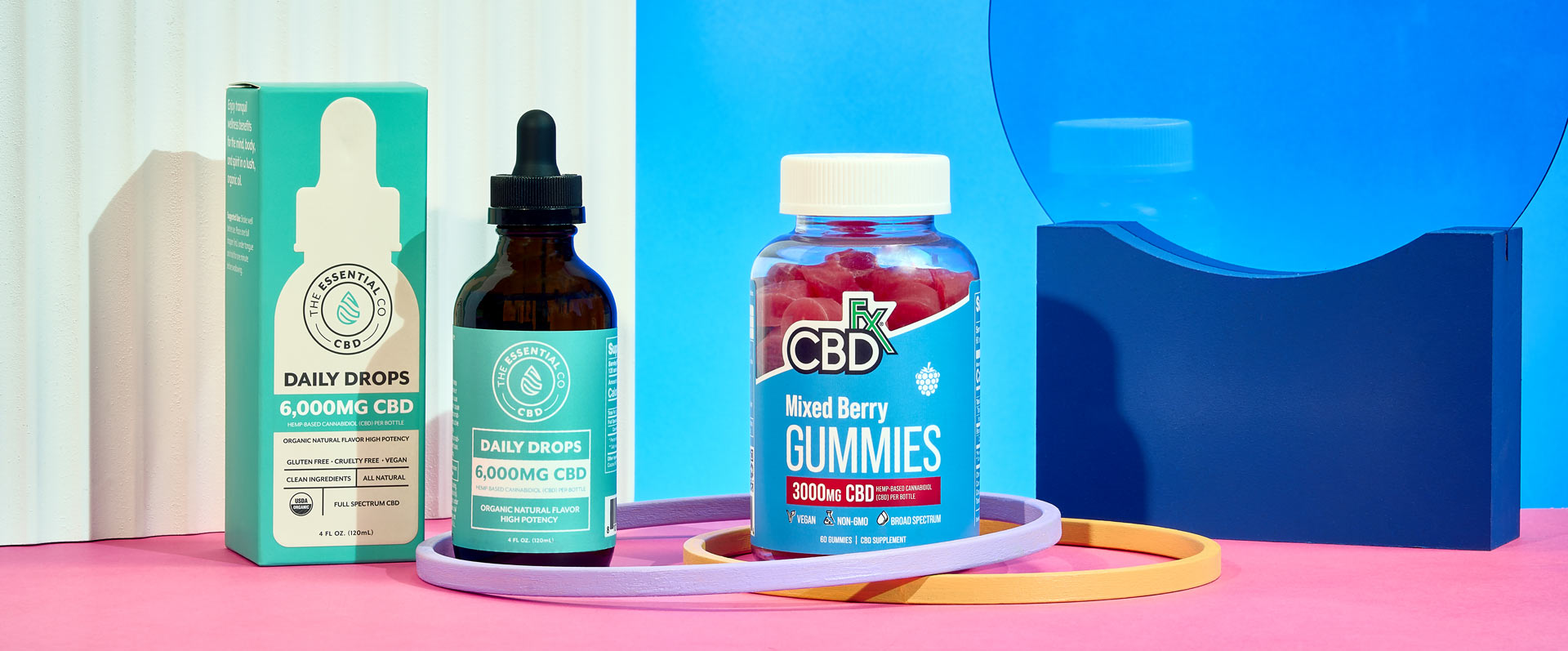CBD is short for cannabidiol, and cultures have been enjoying its therapeutic benefits for thousands of years.[1] But in the last decade, interest in CBD has swirled to an all-time high, creating a market that eclipsed $1.9 billion in 2022.[2] With this recent spike in popularity, the CBD market can feel a little intimidating, for beginners and experts alike.
Learning more about CBD, its benefits, and how to enjoy it best can (unfortunately) leave you with more questions than answers—no matter your level of experience. Maybe you’re a seasoned pro who’s looking to expand your understanding of hemp-based CBD products. Or, you’re only a beginner who’s eager to start your CBD journey, albeit a little overwhelmed by all the information and seemingly endless catalog of products.
Don’t worry. We’re here to help!
We’ve designed this article as a guide to all things CBD. Here, we’ll help beginners and experts alike navigate the ever-changing CBD market. You’ll learn detailed answers to your burning questions like “What Is CBD?”, “How Do You Take CBD?” and “What Is the Right CBD Product for You?” Plus, you’ll find a few best-selling products to kickstart your CBD wellness routine!
So, first, let’s start with the basics and define a key term: CBD.
Cannabidiol 101
While CBD is a single compound in the cannabis plant, it is one of over a hundred unique compounds in the cannabinoid family; many CBD products are rich with a whole host of cannabinoids.
CBD is non-psychoactive, providing users with wellness-boosting benefits that relax the mind and body. CBD, as well as other cannabinoids, accomplishes these effects by interacting with your endocannabinoid system.[3] Your endocannabinoid system is a vital network of receptors that span all across your body, connecting different organs and systems. These receptors regulate essential physiological functions like sleep, mood, appetite, memory, and more. When you take a CBD product, the cannabinoids from that product mimic the body’s own endocannabinoids, bolstering the system’s functions and leading to a cascade of calming, wellness-boosting effects.**
However, not all CBD products carry the same type of CBD. In fact, there are three different forms of CBD that companies infuse their products with, each one offering its own trade-offs.
Full Spectrum CBD
When companies set out to make high-quality CBD products, they all start with a raw, matured hemp plant. From here, there are a couple paths they can choose. The first path produces what is known as full spectrum CBD—the most complete form of hemp-derived CBD. Keep in mind that hemp is naturally rich in CBD and very low (less than 0.3% by dry weight) in THC. To make full spectrum CBD, companies meticulously use safe extraction methods to strip away only the unnecessary plant material, leaving hemp’s essential compounds intact.
This type of CBD contains hemp’s full cannabinoid profile, which carries over a hundred different cannabinoids. Plus, full spectrum CBD boasts hemp’s signature terpenes and flavonoids, the aromatic compounds that give the plant its iconic funky flavors, colors, and scents. These compounds also offer their own unique wellness-based benefits.
When you take a full spectrum CBD product, your endocannabinoid receptors bind with multiple cannabinoids simultaneously, which can create more profound wellness-boosting benefits.[4] This sensation is the Entourage Effect, and it’s a phenomenon thought to be triggered by the combined effects of CBD, THC, terpenes, and flavonoids—all the natural compounds found in full spectrum CBD. When these multiple compounds absorb into your body, they may result in a better effect and additional health benefits than isolate CBD alone.** This is why many choose full spectrum CBD over the other two types of CBD.
So, if full spectrum CBD can create a stronger cascade of wellness benefits, why do companies make other types of CBD? Why do users choose other types of CBD? The answer lies in full spectrum CBD’s THC content.
Since full spectrum CBD carries hemp’s complete cannabinoid profile, it contains hemp’s low THC percentage, which is less than 0.3% by dry weight. This percentage is fairly arbitrary but has important legal implications when defining hemp vs. cannabis. Though this is relatively low, less than 0.3% may still be too much for users who want to avoid detectable levels of THC entirely.
For these customers, brands make broad spectrum CBD.
Broad Spectrum CBD
Broad spectrum CBD is similar to full spectrum CBD, but has gone through additional filtration. This additional filtration whittles the hemp extract’s THC percentage to undetectable levels. Broad spectrum CBD retains most of hemp’s other minor cannabinoids, terpenes, and flavonoids. So, you can still enjoy CBD’s popular wellness benefits.
The main potential drawback to broad spectrum CBD relates to the Entourage Effect. Since broad spectrum CBD has an incomplete cannabinoid profile, you might not feel as profound effects compared to full spectrum CBD (though you may still benefit from the Entourage Effect). But for users who want to enjoy hemp’s all-natural, diverse compounds, while avoiding detectable levels of THC, broad spectrum CBD is perfect for you.
CBD Isolate
The last type of CBD companies infuse their products with is CBD isolate—the purest form of CBD. CBD isolate contains 99% CBD, meaning all other natural compounds have been carefully stripped away. This type of CBD lets users enjoy a CBD-exclusive experience, one that brings all the potential health benefits of CBD—and only CBD.
Full Spectrum vs. Broad Spectrum vs. CBD Isolate
| Type of CBD | Featured Cannabinoids | THC Percentage | Additional Compounds |
|---|---|---|---|
| Full Spectrum CBD | CBD and over a hundred more cannabinoids | Less than 0.3% | Flavonoids and terpenes |
| Broad Spectrum CBD | CBD and over a hundred more cannabinoids | Undetectable levels | Flavonoids and terpenes |
| CBD Isolate | 99% CBD | None | N/A |
Benefits of CBD
That gets us into the benefits of CBD. Known for its myriad of total mind-body benefits, CBD can aid in managing minor aches and pains, stress relief, sleep, and general wellness.** Brands also craft different CBD products with accompanying all-natural ingredients to improve energy, enhance focus, or deepen relaxation.** These special formulas help users enjoy effects complementary to CBD’s benefits. Plus, companies formulate pet-friendly CBD products to help Fido and Fluffy enjoy this bevy of benefits, too!
All the Ways to Enjoy CBD
CBD is a versatile compound. Companies can easily add it to a wide range of products, from gummies to vapes to creams and balms. But each type of CBD product introduces cannabinoids into your body differently. These different routes create changes in the duration and potency of effects. So, understanding the different types of CBD products can help you make a more informed decision before your purchase.

CBD Gummies
CBD gummies are a soft, sweet edible health supplement that carries an effective dose of CBD. Often, CBD gummies boast delicious fruit flavors, like mixed berries, mango, blueberry, and more. Similar to other CBD edibles, CBD gummies break down along your digestive system, where cannabinoids trek through your liver and into your bloodstream. From here, the cannabinoids go on to interact with endocannabinoid receptors all around your body and incite their non-psychoactive, wellness-boosting benefits.**
But, this path takes time, longer than other forms of CBD, and is dependent on personal bioavailability factors, like height, weight, and body composition. So, you can’t expect to feel the calming effects of CBD gummies right away. Rather, it can generally take 30 minutes to two hours for the CBD gummy to fully absorb. These effects can potentially last six to eight hours, a feature unique to CBD edibles.
CBD Capsules
Next, we have a CBD product that takes the same route as CBD gummies: CBD capsules. CBD capsules are premeasured tablets that often contain other all-natural, healthful ingredients to complement CBD’s effects. CBD capsules are best for those who prefer not to measure out a dose of CBD but rather enjoy a premeasured serving. Plus, as CBD edibles, CBD capsules provide longer-lasting effects than other CBD products but can take longer to start working compared to gummies.

CBD Oil Tinctures
CBD tinctures contain hemp-derived oil that’s taken sublingually (under your tongue). Most tincture bottles come with a 1mL dropper attached to the lid. This dropper lets you customize your dose and measure full or partial servings. When you place CBD tincture oil under your tongue, the capillaries in your mouth absorb the cannabinoids and usher them into your bloodstream, bypassing the digestive system entirely. This path leads to a quicker, more potent onset of effects—the main reason many choose CBD tinctures as their go-to CBD product.
CBD Vapes
CBD vapes come in a couple forms, including vape pens, vape cartridges, and vape juices. All of these methods require a personal, portable vaporizer to use. CBD vape pens are the only type of e-vape with a built-in vaporizer and battery. CBD vapes carry cannabinoid-rich vape juice, often flavored with strain-specific terpenes and a balanced ratio of propylene glycol (PG) and vegetable glycerine (VG). The battery in the personal vape device heats the CBD-rich vape juice, creating a vapor. After you inhale the vapor, the cannabinoid filters through your lungs and directly into your bloodstream, a near-instant handoff. This is how CBD vapes create fast-acting effects that can potentially last 30 minutes to two hours.
CBD Topicals
CBD topicals, like balms, creams, bath bombs, and more, are perhaps the most unique CBD product category. When you apply CBD-rich lotion to your skin, the cannabinoid absorbs through the skin barrier and directly into the underlying tissues to soothe minor aches and pains.** Unlike all other forms of CBD, cannabinoids from topicals never enter your bloodstream. So, they only provide localized relief. Customers choose topicals over other types of products to pinpoint CBD soothing effects on sore muscles or aching joint pain.**
CBD for Pets
Did you know animals have an endocannabinoid system, too? And yes, that includes your pets! [5] Many companies have carefully formulated CBD products for pets to let your furry little friends enjoy the potential health benefits of CBD. There are many different types of tail-waggin’ CBD pet products, from dog treats to pet tinctures to pet balms.
Want a more in-depth look at all the ways to enjoy CBD?
Guide to CBD Dosage
Whether it’s your first or 500th time enjoying the calming benefits of CBD, it’s always best to know your optimal dose. This search for your ideal dose may take some trial and error. But, after a little research, you can take that first (or 500th) serving confidently!
Here, we’ll teach you how to find the best dose of CBD for you!
CBD vs. THC
Now, let’s decipher the difference between hemp’s two most abundant cannabinoids: CBD and THC. While we’ve already mentioned the potential health effects of cannabidiol, tetrahydrocannabinol (THC) might still be a mystery to you. Take a minute to imagine the classic cannabis experience. And don’t kid yourself; CBD gummies aren’t the first things that come to mind. Typically, it’s the iconic “high” that pops into most people’s minds. This “high,” with its red eyes and euphoric feelings, is the result of THC, cannabis’ main psychoactive cannabinoid.
Here, we discuss the difference between CBD and THC, and what users can expect from both popular cannabinoids.
CBD and Drug Tests
While drug screening may be random or routine, knowing how CBD products affect certain types of tests may help you avoid a false positive. Here, we go more in-depth on how to use CBD confidently if drug tests linger in the future.
Types of Cannabis: Hemp vs. Marijuana
Through your online research, you might see “hemp,” “marijuana,” and “cannabis” used interchangeably. This is one of the biggest misconceptions in the cannabis space. So, let’s dispel some misinformation about “hemp,” “marijuana,” and “cannabis.”
Hemp and marijuana are the two types of cannabis plants but are technically the same species. While both cannabis plants have similar appearances and aromas, their primary difference lies at the molecular level, in their THC percentages. Marijuana can have upwards of 30% THC, while nature (and the law) regulates hemp’s THC percentage to less than 0.3%—a pretty drastic difference.
Still, cannabidiol (CBD) is a compound found in marijuana, just at lower concentrations compared to hemp. This difference between hemp and marijuana is what the 2018 Farm Bill set out to define.

The Legal Status of CBD in 2024
If your online research has led you to the term “2018 Farm Bill,” then you are definitely in the cannabis—pun intended. Among other things, the 2018 Farm Bill set out to federally define the differences between cannabis plants, citing hemp’s miniscule THC percentage as the red dividing line: less than 0.3% by dry weight. This Farm Bill effectively legalized the agricultural production, distribution, and sale of hemp nationwide.[7]
However, some states and local municipalities have taken cause in recent years, challenging this legislation. Plus, the upcoming 2023 Farm Bill (set to be published in 2024) promises updated policies on hemp. So, what does the future hold for hemp?
Finding the Right CBD Products for You
When doing your own research into hemp products, it’s always best to start by finding the right brand. But, what does “the right brand” look like? Here, we break down what we screen for when choosing the brands featured on our online shelves.
High-Quality Hemp
With its five-leaf design, the hemp plant carries an iconic look; you’ve undoubtedly recognized it on stickers, logos, and packaging. But you might not know the science surrounding hemp cultivation, and why you should always choose products made with organic hemp over those that aren’t.
Hemp is naturally very absorbent, meaning it absorbs almost anything in its surrounding soil. This includes the soil’s rich nutrients, minerals, and water. This also, unfortunately, includes any herbicides, pesticides, or heavy metals. Hemp absorbs those toxic chemicals, too. In fact, in 2001, scientists planted hemp plants around Chernobyl to rid the soil of toxic heavy metals.[6]
So, a company needs to be careful during their cultivation, or toxic agriculture chemicals can leak their way into the finished product. This is why it’s important to choose companies that make their cannabis products with organic hemp. And the way you find out if a brand does so is by checking their third-party lab tests (Certificate of Analysis).
Verify With Third-Party Lab Tests
Look at a Certificate of Analysis as a report card for hemp brands. These independent tests show whether the brand followed gold-standard practices, or cut corners and rushed the manufacturing process. These lab tests show if any harmful chemicals like herbicides, pesticides, and heavy metals remain in the finished product. They also let customers verify purity and potency. A brand that publishes their products with third-party lab tests opts for full transparency. A brand that doesn’t—well, they don’t make the cut into our curated selection.
Choose “Cannabidiol” Over “Hemp Seed Oil”
If you shop at any other major online retailer, you may encounter products made with hemp seed oil claiming to be CBD products. “Hemp seed oil” and “hemp-based cannabidiol” may sound like the same thing, but they are vastly different. Hemp seed oil is made from the seed only and has nourishing properties used in many beauty products. CBD hemp oil is cultivated from hemp’s leaves, flowers, and stalks, all of which are rich in wellness-boosting cannabinoids. So, when in doubt, check the lab reports and the product’s label, and choose products made with hemp-derived cannabidiol.
Final Thoughts
With all this in mind, the market for hemp-based products is still blossoming, and the science around cannabis is still in an exciting stage of discovery.
At CBD.co, our goal is to make your shopping experience simple, transparent, and comprehensive, giving you a wide selection of products, from raw CBD flower to luxurious CBD bath bombs. We aim to be your one-stop shop for all your hemp- and mushroom-based needs!
Ready to add CBD to your daily routine? Check out our assortment of CBD gummies from industry leaders like CBDfx, Canna River, Charlotte’s Web, and more!
-
- Crocq M. A. (2020). History of cannabis and the endocannabinoid system. Dialogues in clinical neuroscience, 22(3), 223–228. https://doi.org/10.31887/DCNS.2020.22.3/mcrocq
-
- Hall, A. (2023, June 22). CBD Statistics, Data And Use (2024). Forbes Health. https://www.forbes.com/health/cbd/cbd-statistics/#cbd_statistics_at_a_glance_section
-
- Yarar E. (2020). Role and Function of Endocannabinoid System in Major Depressive Disease. Medical cannabis and cannabinoids, 4(1), 1–12. https://doi.org/10.1159/000511979
-
- How CBD and THC Work Together: The Entourage Effect. (2019, December 13). Healthline. https://www.healthline.com/health/the-entourage-effect
-
- Coile PhD, C. (2023, February 2). Does CBD Work for Dogs? American Kennel Club. https://www.akc.org/expert-advice/health/does-cbd-work-for-dogs/
-
- Leonard, A. (2018, June 11). Can Hemp Clean Up the Earth? Rolling Stone. https://www.rollingstone.com/politics/politics-features/can-hemp-clean-up-the-earth-629589/
-
- U.S. Department of Agriculture. “Farm Bill.” https://www.usda.gov/farmbill. December 20, 2018.



